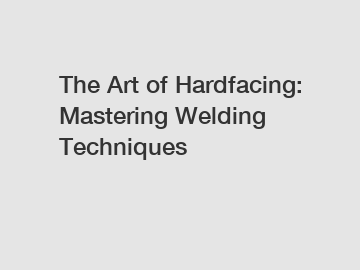The Art of Hardfacing: Mastering Welding Techniques
The Art of Hardfacing: Mastering Welding Techniques—How Can You Become a Master?
The art of hardfacing is a crucial skill for welders in various industries. From manufacturing to construction, the ability to effectively repair and strengthen metal surfaces can greatly enhance the lifespan and performance of critical components. In this article, we delve into the world of hardfacing and explore techniques that can help you master this important welding skill.
1. Understanding Hardfacing:

Hardfacing involves depositing a harder material onto the surface of a metal to increase its durability, resistance to wear, and corrosion properties. This process is commonly used in industries such as mining, oil and gas, power generation, and agriculture. By mastering the techniques of hardfacing, welders can save companies significant costs by extending the life of equipment and reducing frequent replacements.
2. Selecting the Right Hardfacing Materials:
The choice of hardfacing materials depends on the specific application and the type of wear the surface is subjected to. Several factors, such as base metal composition, operating conditions, impact, and abrasion resistance, influence material selection. Welders must evaluate these factors and choose from a range of options, including cobalt-based alloys, nickel-based alloys, and chromium carbides, to ensure the desired performance and longevity.
3. Mastering Different Hardfacing Techniques:
a. Manual Metal Arc Welding (MMA): Also known as shielded metal arc welding or stick welding, MMA is a commonly used technique for hardfacing. This process involves a consumable electrode coated with flux, which provides a shield against impurities. It is versatile, cost-effective, and suitable for field repairs. Proper electrode selection, correct amperage, and maintaining consistent arc length are key factors in mastering this technique.
b. Gas Metal Arc Welding (GMAW): GMAW, or MIG welding, utilizes a continuous wire electrode and a shielding gas to protect the weld pool from atmospheric contamination. This technique allows for higher deposition rates, making it ideal for larger-scale hardfacing jobs. Skillful control of the arc, wire feed rate, and shielding gas mixture are crucial in achieving high-quality hardfacing results.
c. Tungsten Inert Gas Welding (TIG): TIG welding is commonly used when precise control and a high-quality finish are required. With the ability to weld thinner materials, it is favored for hardfacing applications on components such as valve seats and turbine blades. TIG welding requires excellent hand-eye coordination and precise control of the heat input and filler metal.
4. Proper Surface Preparation:
Achieving a successful hardfacing outcome heavily relies on the adequate preparation of the base metal surface. Before beginning the hardfacing process, thorough cleaning, and removal of contaminants such as rust, oil, and paint is essential. Pre-weld cleaning methods, such as grinding, sandblasting, or chemical cleaning, should be employed to ensure optimal bonding between the base metal and the hardfacing material.
5. Importance of Post-Weld Heat Treatment:
Post-weld heat treatment plays a vital role in relieving any residual stresses, improving the weld's properties, and preventing cracking. Depending on the hardfacing material, a specific heat treatment process may be required to achieve the desired metallurgical structure. By following the recommended post-weld heat treatment procedures, welders can ensure the integrity and longevity of the hardfaced surface.
In conclusion, mastering the art of hardfacing is crucial for welders looking to excel in their craft. By understanding the principles and techniques involved, selecting the appropriate materials, and practicing proper surface preparation and heat treatment, welders can achieve durable and effective hardfaced surfaces. So, if you aspire to become a master in welding techniques, embark on the journey of mastering the art of hardfacing and unlock a world of opportunities in various industries.
For more information, please visit overlay wear plate supplier, china chromium carbide welding wire supplier, china hardfacing plate.
197
0
0

Comments
All Comments (0)